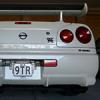How do you tell a Modified/Custom R33 GTS-T from a customised R33 GTR
Announcements
-
Similar Content
-
Latest Posts
-
Oh please, when has anybody really been "done" when they say that? 😂
-
The part where you claim the car "is done" means you won't...
-
Johnny is sad now... Because you didn't get Bosch Motorsport ABS.
-
Hey keep the ideas coming, I'm always keen on projects! But, problem fixed! I got a cheapie ozito scope from Bunnings and had a good look in and around the bearing and sensor hole. I couldn't see a smoking gun but the bearing looked a bit strange, especially when comparing with a new one. I thought the cover had come off the bearing magnets. Sorry for pics of a screen, I didn't have an SD card. Good thing I had the old one to inspect. So, given I'm like a pit crew with wheel bearings and luckily I had a spare bearing because I f**ked up my parts order, I decided to just smash it out. Got the old one out in about an hour. So much easier when the parts haven't had a chance to rust together yet. 😂 And, well, found the problem. In the second pic at about the 8 o'clock position, you'll see what I think is the tip of the old sensor. The new sensor has definitely been rubbing but it's all intact, just a little shiny so I'm hoping it's fine. The car brakes perfectly now and no errors. I think the job took about 2.5h in the end. 👍🏻 I really appreciate the help in here as usual. Thanks guys.
-








Recommended Posts
Create an account or sign in to comment
You need to be a member in order to leave a comment
Create an account
Sign up for a new account in our community. It's easy!
Register a new accountSign in
Already have an account? Sign in here.
Sign In Now